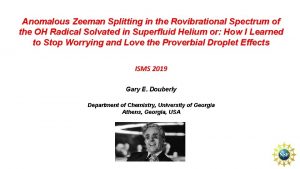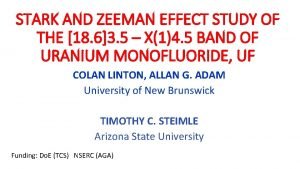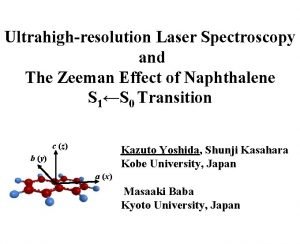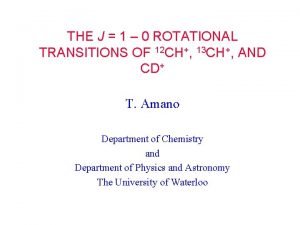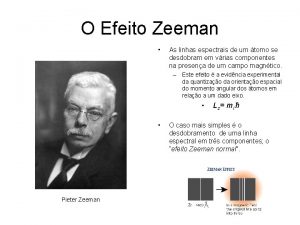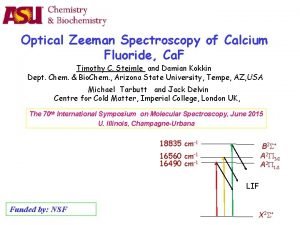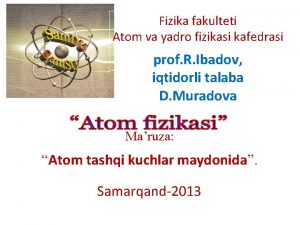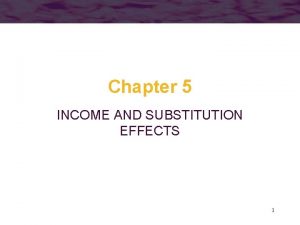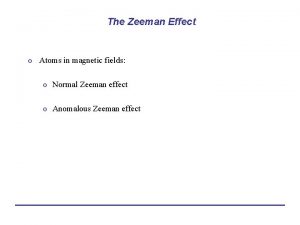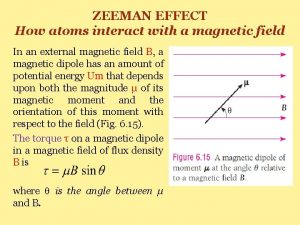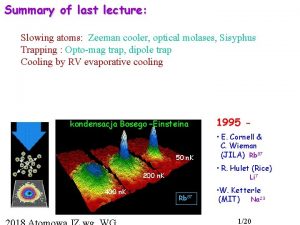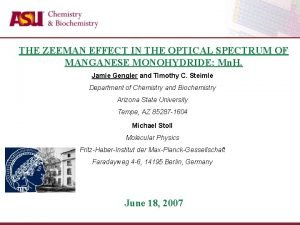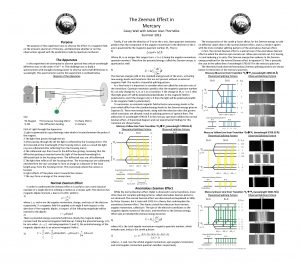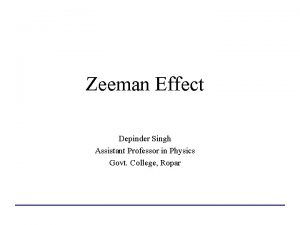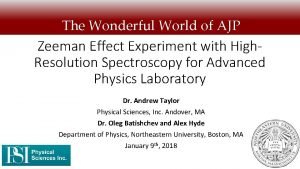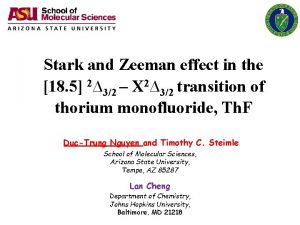Lecture 12 The Zeeman Effect o Atoms in














- Slides: 14

Lecture 12: The Zeeman Effect o Atoms in magnetic fields: o Normal Zeeman effect o Anomalous Zeeman effect o Astrophysical applications PY 3 P 05

Zeeman Effect o First reported by Zeeman in 1896. Interpreted by Lorentz. o Interaction between atoms and field can be classified into two regimes: B=0 o Weak fields: Zeeman effect, either normal or anomalous. B>0 o Strong fields: Paschen-Back effect. o Normal Zeeman effect agrees with the classical theory of Lorentz. Anomalous effect depends on electron spin, and is purely quantum mechanical. Photograph taken by Zeeman PY 3 P 05

Norman Zeeman effect o Observed in atoms with no spin. o Total spin of an N-electron atom is o Filled shells have no net spin, so only consider valence electrons. Since electrons have spin 1/2, not possible to obtain S = 0 from atoms with odd number of valence electrons. o Even number of electrons can produce S = 0 state (e. g. , for two valence electrons, S = 0 or 1). o All ground states of Group II (divalent atoms) have ns 2 configurations => always have S = 0 as two electrons align with their spins antiparallel. o Magnetic moment of an atom with no spin will be due entirely to orbital motion: PY 3 P 05

Norman Zeeman effect o Interaction energy between magnetic moment and a uniform magnetic field is: o Assume B is only in the z-direction: o The interaction energy of the atom is therefore, where ml is the orbital magnetic quantum number. This equation implies that B splits the degeneracy of the ml states evenly. PY 3 P 05

Norman Zeeman effect transitions o But what transitions occur? Must consider selections rules for ml: ml = 0, ± 1. o Consider transitions between two Zeeman-split atomic levels. Allowed transition frequencies are therefore, o Emitted photons also have a polarization, depending on which transition they result from. PY 3 P 05

Norman Zeeman effect transitions o Longitudinal Zeeman effect: Observing along magnetic field, photons must propagate in zdirection. o Light waves are transverse, and so only x and y polarizations are possible. o The z-component ( ml = 0) is therefore absent and only observe ml = ± 1. o Termed -components and are circularly polarized. o Transverse Zeeman effect: When observed at right angles to the field, all three lines are present. o ml = 0 are linearly polarized || to the field. o ml = ± 1 transitions are linearly polarized at right angles to field. PY 3 P 05

Norman Zeeman effect transitions o Last two columns of table below refer to the polarizations observed in the longitudinal and transverse directions. o The direction of circular polarization in the longitudinal observations is defined relative to B. o Interpretation proposed by Lorentz (1896) s- s+ ( ml=-1 ) ( ml=0 ) ( ml=+1 ) PY 3 P 05

Anomalous Zeeman effect o Discovered by Thomas Preston in Dublin in 1897. o Occurs in atoms with non-zero spin => atoms with odd number of electrons. o In LS-coupling, the spin-orbit interaction couples the spin and orbital angular momenta to give a total angular momentum according to o In an applied B-field, J precesses about B at the Larmor frequency. o L and S precess more rapidly about J to due to spin-orbit interaction. Spin-orbit effect therefore stronger. PY 3 P 05

Anomalous Zeeman effect o Interaction energy of atom is equal to sum of interactions of spin and orbital magnetic moments with B-field: where gs= 2, and the < … > is the expectation value. The normal Zeeman effect is obtained by setting and o In the case of precessing atomic magnetic in figure on last slide, neither Sz nor Lz are constant. Only is well defined. o Must therefore project L and S onto J and project onto z-axis => PY 3 P 05

Anomalous Zeeman effect o The angles 1 and 2 can be calculated from the scalar products of the respective vectors: which implies that o Now, using (1) implies that therefore so that o Similarly, and PY 3 P 05

Anomalous Zeeman effect o We can therefore write Eqn. 1 as o This can be written in the form where g. J is the Lande g-factor given by o This implies that and hence the interaction energy with the B-field is o Classical theory predicts that gj = 1. Departure from this due to spin in quantum picture. PY 3 P 05

Anomalous Zeeman effect spectra o Spectra can be understood by applying the selection rules for J and mj: o Polarizations of the transitions follow the same patterns as for normal Zeeman effect. o For example, consider the Na D-lines at right produced by 3 p 3 s transition. PY 3 P 05

Sunspot magnetography o Measure strength of magnetic field from spectral line shifts or polarization. o Choose line with large Lande g-factor => sensitive to B. o Usually use Fe I or Ni I lines. o Measures field-strengths of ~± 2000 G. PY 3 P 05

Sunspot magnetography PY 3 P 05
